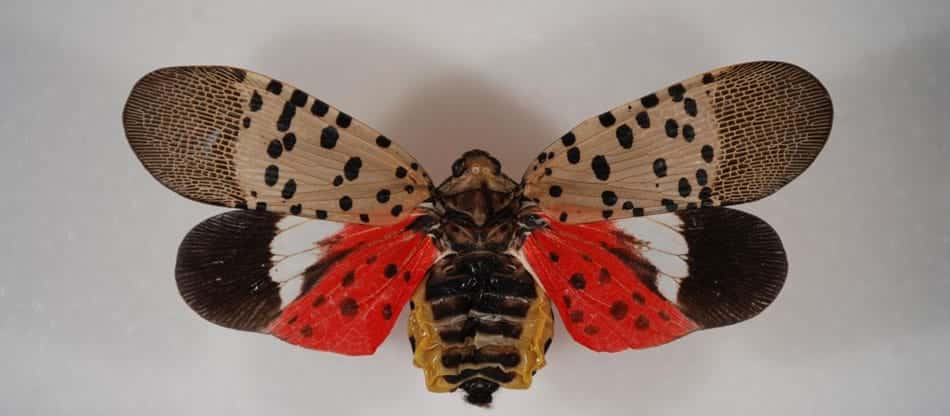
Facts About Spotted Lanternfly In New Jersey & Pennsylvania
Organic Knock Down
Spotted Lanternfly Suppression
We now offer spotted lanternfly treatments to suppress the egg-laying population and reduce the damage they cause. In the late summer (usually starting in late July - early August), we use a highly effective organic pesticide that is sprayed on trees and plants where spotted lanternflies gather. It quickly kills the adults feeding on the sap and minimizes the number of eggs that are laid (reducing the number of lanternflies that would otherwise hatch next year). The pesticide is made from botanically-derived active ingredients – pyrethrins, exacted from chrysanthemums - is OMRI listed, has no residual, and is suitable for use on organic crops.
Since it's discovery in Pennsylvania in 2014, the spotted lanternfly has spread to eight states and shows no signs of stopping. Aside from the nuisance factor (the bugs swarm everywhere, including on people), the spotted lanternfly has already caused millions of dollars of damage to trees, crops, and landscapes.
Spotted Lanternfly Quarantine Areas
The NJ Department of Agriculture confirmed that the spotted lanternfly has been detected in parts of Burlington, Camden, Gloucester, Hunterdon, Mercer, Salem, Somerset and Warren counties in New Jersey. As a result, these counties are now under quarantine.
In Pennsylvania, all of Bucks County is under quarantine, as are Berks, Carbon, Chester, Dauphin, Delaware, Lancaster, Lebanon, Lehigh, Monroe, Montgomery, Northampton, Philadelphia, and Schuylkill counties. Call the Pennsylvania Department of Agriculture hotline at 1-888-4BADFLY to report sightings of this invasive insect.
If you are moving any of the articles on this list out of those counties, you’ll need to check carefully for spotted lanternfly and certify that you have done so.
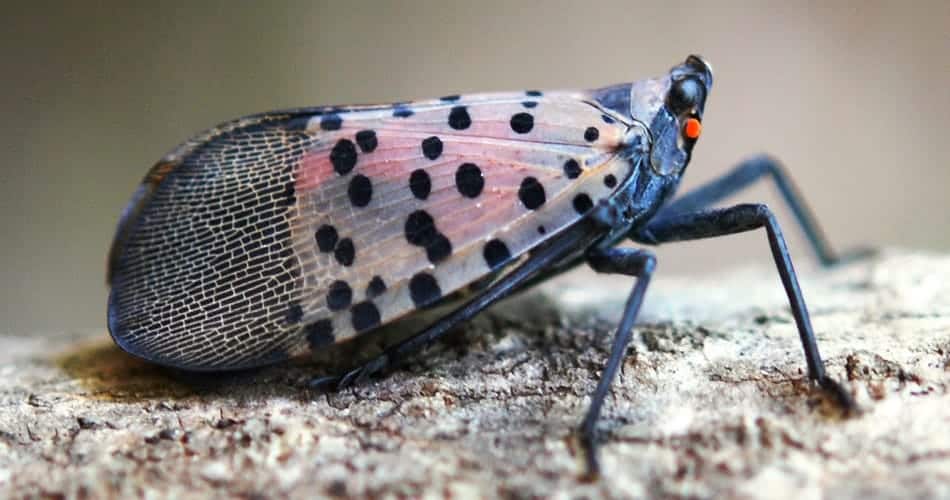
Adult spotted lanternfly - Image courtesy of Lawrence Barringer, Pennsylvania Department of Agriculture, Bugwood.org
What Is The Spotted Lanternfly?
Spotted lanternfly (SLF), Lycorma delicatula, is an invasive planthopper native to Southeast Asia. It was first discovered in Berks County, Pennsylvania in 2014 and has since spread to neighboring counties and states.
The pest gets its name from spots that decorate its back and wings, and is quite attractive with its wings spread to show vivid red, black and white areas.
But make no mistake about it – this insect wreaks havoc wherever it goes.
Spotted Lanternfly Damage in New Jersey & Pennsylvania
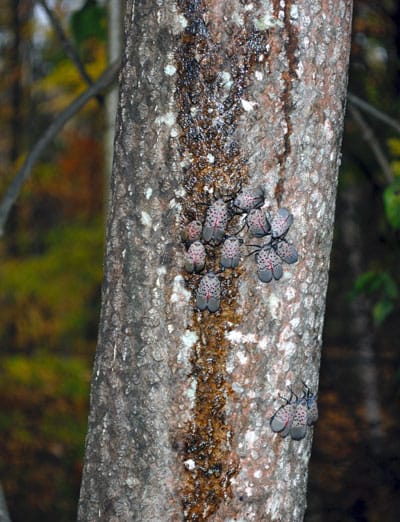
As spotted lanternflies feed, sap and honeydew run down the tree, leaving it prone to black sooty mold
The spotted lanternfly feeds on woody plants, sucking out sap and leaving behind honeydew, a sticky, sugary liquid that encourages the growth of black sooty mold on any surfaces it covers. While sooty mold is harmless to people, it can damage plants (and it’s rather unsightly).
SLF feeding damages the tree or plant, resulting in oozing sap running down the trunk, wilting, leaf curling and even plant death. It also destroys fruit from that plant, partially through direct damage and partially by covering it with sooty mold, making it unappetizing and not suitable for commercial use. Apples from apple trees, grapes from vineyards, and hops for making beer are just some examples of fruit that has been ruined by this pest. In Pennsylvania alone, authorities estimate that $18 billion worth of agricultural commodities are at risk of destruction from the spotted lanternfly.
The spotted lanternfly is most commonly found on the Tree of Heaven (Ailanthus altissima), but over 70 varieties of woody plants can be damaged by SLF at any stage of development. For example, it’s known to feed on many common shade trees, such as red and sugar maples, chestnut oaks, tuliptrees, and American sycamores.
Aside from the damage to trees and agricultural crops, SLF tends to congregate in hoards (often around Ailanthus trees) that cover everything in sight, making it unpleasant to be outdoors – especially when adults take to the skies in swarms as part of the mating process. In recent years it's moved into urban areas, swarming around highrise buildings, parks and along roadways.
The insect is toxic if consumed (so keep your pets away from it!) and has no natural predators here in the USA, making it extremely difficult to control.
What To Look For
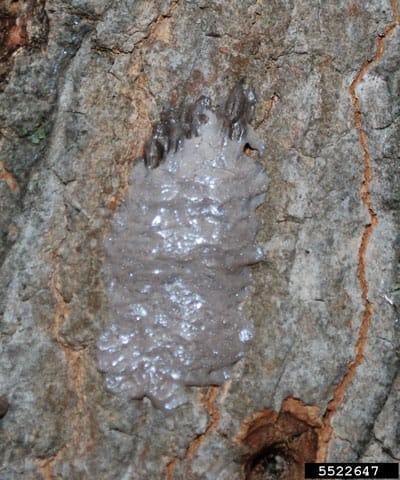
The lighter brown, slightly shiny area is a spotted lanternfly egg mass - Image courtesy of Pennsylvania Department of Agriculture, Bugwood.org
The spotted lanternfly has 4 stages of development: eggs, two nymph stages and adult.
SLF egg masses appear shiny and grayish brown (somewhat like a smear of mud), making them difficult to see if they’re on a tree. Eggs can be present from late September through May.
Egg masses can be left on nearly any surface, including logs, outdoor, camping and recreational equipment, and cars or trailers that are then transported to other areas and states, which is one way that the pest has spread to other areas.
After eggs hatch (starting in April), the SLF goes through several stages (called nymphs) before reaching maturity. These nymphs are present from late April through mid-October. They’re small (1/4 to ½ inch) but quite capable of inflicting damage on host plants and hitching a ride to new feeding grounds.
Adults are around 1 inch long and can be seen from late July through mid-December. They’re often seen in large groups
Black sooty mold or sticky areas on a plant or tree are good indicators of SLF feeding. However, other pests can also cause similar symptoms, such as aphids, leafhoppers, planthoppers and scale insects.
You may also see an increase in wasps, bees, ants, and hornets that are attracted to the weeping wounds left by SLF.
If you see these signs on your tree and aren’t sure what’s causing it, give us a call and one of our Tree Experts will inspect it and give you a diagnosis.
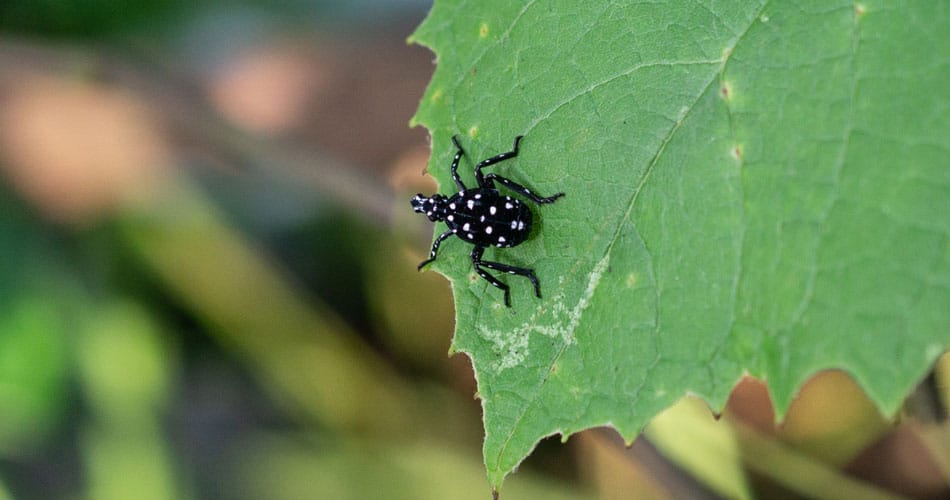
Early state spotted lanternfly nymph
Management of Spotted Lanternfly
The spotted lanternfly is highly mobile; there’s no way to keep it off your property. It’s just a matter of time before you find one (or many!).
There are two ways to control the spread and amount of damage caused by SLF –
- preventive treatments (such as removing egg masses) and
- directly targeting the nymphs and adults with a variety of insecticides.
And if you see one nearby, step on it, squash it, or otherwise get rid of it. Do whatever you can to kill the spotted lanternfly - without any natural predators in the USA, it's up to us to do whatever is necessary to control the threat posed by this invasive insect.
Preventive Treatments for Spotted Lanternfly
Prevention focuses on two things – preventing eggs from hatching and preventing nymphs from reaching the tree canopy where they feed.
One option is to manually remove egg masses by scraping them off surfaces and destroying them (such as by immersing them in rubbing alcohol, bleach or hand sanitizer – just leaving them on the ground won’t kill them). You can also place them in a sealed plastic bag and dispose of them. You’ll usually find egg masses between September and June.
The problem with this is that egg masses can be high up in the trees where you can’t reach them, they’re hard to see, and they can be on just about any surface, including under your car! Plus, even if you eliminated all egg masses on your own property, new lanternflies will come in from neighboring properties.
To prevent nymphs from climbing tree trunks, you can place a sticky band around the trunk to trap them as they climb. You can buy bands specifically for this purpose or wrap your trees with duct tape (sticky side out). Bands should be in place in early spring to catch newly emerging nymphs – it’s not effective against flying adults.
Because the Tree of Heaven is the preferred host for SLF, preemptively removing all (or most – see below) of these trees on your property can significantly cut down on the number of pests. Tree of Heaven can reach 100 feet tall and must be treated with herbicide before being cut down; it’s best to call in a tree care professional for the job. Trees should be removed between July and September.
Chemical & Biological Treatments for Spotted Lanternfly
Synthetic Insecticides
Experts are still investigating the best means of controlling SLF. At the moment, the US Department of Agriculture is using the systemic insecticide dinotefuran (a neonicotinoid) as an injection or bark spray to kill SLF. Both methods appear to work well but can only be applied by a tree care professional. Neonicotinoids also have a well-known detrimental effect on beneficial insects, including honeybees.
Organic Insecticides
A more recent option is an organic insecticide containing pyrethrins. It's sprayed on the tree and ingested by the adult spotted lanternflies as they feed, leading to a significant reduction in the egg-laying population. This is the approach Organic Plant Care LLC is using (request an estimate for treatment).
The organic pesticide azadirachtin has also shown promise when used as a foliar spray. However, it only works when the pest comes into direct contact with it so it’s best to bring in a professional who has the spray equipment necessary to get full coverage of all trees on your property.
Using Trap Trees
One method that’s gaining attention is to use trap trees. By removing all but a few of the most attractive (to SLF) male Trees of Heaven on a property, the pest is forced to feed on the remaining trees. These can then be treated with a systemic insecticide that kills all SLF who feed on the trap trees. Although the pesticides known to be effective against SLF are toxic and non-selective (they kill other insects too, including beneficial insects and pollinators), using trap trees reduces the total amount of insecticide used in comparison to other approaches. For best results, apply the insecticide in June through August.
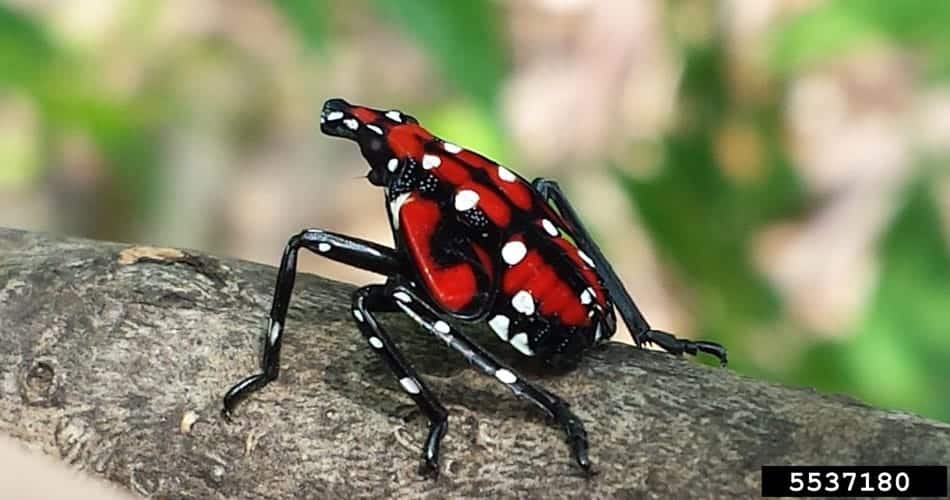
Later stage spotted lanternfly nymph - Image courtesy of Lawrence Barringer, Pennsylvania Department of Agriculture, Bugwood.org
If You Find Spotted Lanternfly
Efforts are underway to quarantine and contain SLF before it spreads and does more damage. Here’s what to do in Pennsylvania and New Jersey.
In Pennsylvania
Anyone who finds the insects or egg masses outside quarantined areas should report sightings to badbug@pa.gov. Include photos, if possible, to help confirm the sighting. Suspect specimens can be submitted to the department’s headquarters in Harrisburg or to any of its six regional offices. Specimens in isopropanol or rubbing alcohol can be submitted to county Penn State Extension offices. You may also call the Pennsylvania SLF hotline at 1-888-4BADFLY. Please provide details, including the location of the sighting, and your contact information. Calls may not be returned immediately, as call volume is high.
In New Jersey
Specimens of any life stage can be turned in to the New Jersey Department of Agriculture’s lab for verification (make sure it’s dead before transporting it). If possible, take a photograph of the pest at any life stage (including egg masses). The photo can be submitted to SLF-plantindustry@ag.nj.gov. If you can’t take a specimen or photograph, call the New Jersey Spotted Lanternfly Hotline at 1-833-223-2840 (BADBUG0) and leave a message detailing your sighting and contact information.
And don't forget that you can call on us for a spotted lanternfly inspection, treatment suggestions and Tree of Heaven removal.
